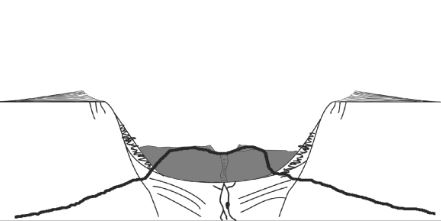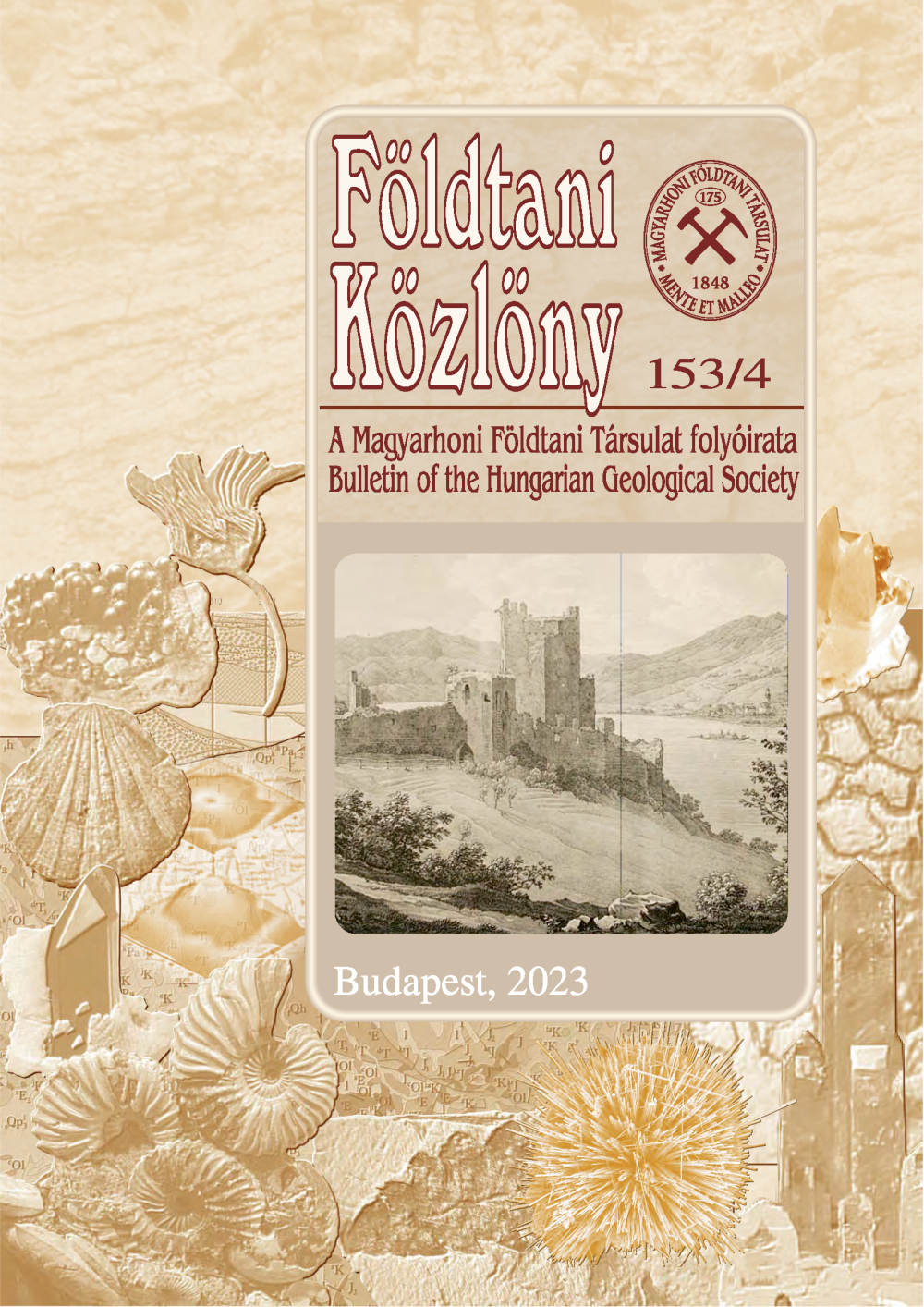A Badacsony freatomagmás piroklasztit-sorozata: következtetések a monogenetikus bazaltvulkáni működés folyamataira és formáira
Absztrakt
A tanulmányban a Bakony–Balaton-felvidéki Vulkáni Terület (BBVT) legismertebb tanúhegyén, a Badacsonyon kibukkanó freatomagmás piroklasztit-sorozat első kvantitatív leírását és vulkanológiai értelmezését mutatjuk be. A piroklasztitok juvenilis / litikus törmelékeinek arányát pontszámlálásos módszerrel vizsgáltuk vágott kézipéldány-felszíneken. A felület%-ban kapott eredményeket a kőzetminták teljes térfogatára vonatkozónak vettük. E módszer segítségével meghatároztuk a freatomagmás robbanások relatív mélységét a szinvulkáni felszínhez képest, következtetéseket vontunk le a lehetséges szineruptív vulkánmorfológiára, valamint a terepi megfigyelések és korábbi tanulmányok alapján rekonstuáltuk a vulkán működésének teljes fejlődéstörténetét.
A képelemzés során megállapítottuk litikus elegyrészek minimális arányát. Ebből, valamint a piroklasztitok térbeli elterjedéséből és rétegtani helyzetéből valószínűsíthető, hogy a Badacsony egy monogenetikus (esetleg policiklikus) tufagyűrű vagy sekély maar vulkán volt, amelynek kialakulásában a víz-magma kölcsönhatás következtében történt sekély mélységű freatomagmás robbanások játszották a fő szerepet. A tufagyűrű vulkáni forma a litoklasztok kis mennyiségével alátámasztható. Viszonylag kevés litoklasztot tartalmazó freatomagmás kitörési termékek nem csak tufagyűrűk, hanem puha, konszolidálatlan kőzeten kialakuló sekély maarok képződményei is lehetnek, amely modell a Badacsony esetében is valószínűsíthető.
A terepi megfigyelések, valamint a képelemzés eredménye alapján a vulkanizmus freatomagmás robbanásos, lávaöntő és magmás robbanásos fázisokra osztható. Ezen adatok alapján vulkáni fejlődéstörténeti modellt állítottunk fel. A kevés korábbi, célzott vulkanológiai szemléletű munka miatt e „kezdeti” adatok megfelelő alapot adhatnak a további badacsonyi vulkanológiai kutatásoknak.
Hivatkozások
AGUSTÍN-FLORES, J., NÉMETH K., CRONIN, J. S., LINDSAY, J. M., KERESZTURI G. 2015: Shallow-seated explosions in the contruction of the Motukorea tuff ring (Auckland, New Zealand): Evidence from lithic and sedimentary characteristics. - Journal of Volcanology and Geothermal Research, 304, pp. 272–286.; http://doi.org/10.1016/j.jvolgeores.2015.09.013
BALOGH K., JÁMBOR A., PARTÉNYI Z., RAVASZNÉ BARANYAI L., SOLTI G. 1982: A dunántúli bazaltok K/Ar radiometrikus kora. - Magyar Állami Földtani Intézet Jelentése 1980, pp. 243–260.
BALOGH K., ÁRVA-SÓS E., PÉCSKAY Z., RAVASZ-BARANYAI L. 1986: K/Ar dating of post-Sarmatian alkali basaltic rocks in Hungary. - Acta Mineralogica et Petrographica, Szeged 28, pp. 75–94.
BORSY Z., BALOGH K., KOZÁK M., PÉCSKAY Z. 1986: Újabb adatok a Tapolcai-medence fejlődéstörténetéhez. - Acta Geographica Debrecina, 23, pp. 79–104.
BUDAI T. & CSILLAG G. (szerk.) 1999: A Balaton-felvidék földtana: Magyarázó a Balaton-felvidék földtani térképéhez, 1:50000. - Magyar Állami Földtani Intézet, 257 p.
BUDAI T., CSILLAG G., DUDKO A., KOLOSZÁR L. 1999: A Balaton-felvidék földtani térképe - Geological map of the Balaton Highland, 1:50000. - Magyar Állami Földtani Intézet, Budapest.
CARMONA, J., ROMERO, C., DÓNIZ, J., GARCÍA, A. 2011: Characterization and facies analysis of the hydrovolcanic deposit of Montana Pelada tuff ring: Tenerife, Canary Islands. - Journal of African Earth Sciences, 59, pp. 41–50. http://doi.org/10.1016/j.jafrearsci.2010.07.003
EMBEY-ISZTIN A. 1976: Amphibolite/lherzolite composite xenolith from Szigliget, north of the lake Balaton, Hungary. - Earth and Planetary Science Letters, 31/2, pp. 297–304. http://doi.org/10.1016/0012-821x(76)90223-5
FISHER, R. V. & SCHMINCKE, H.-U. 1984: Pyroclastic Rocks. - Heidelberg, Springer, 474 p. http://doi.org/10.1007/978-3-642-74864-6
GESHI, N., NÉMETH K., OIKAWA, T. 2011: Growth of phreatomagmatic explosion craters: A model inferred from Suoana crater in Miyakejima Volcano, Japan. - Journal of Volcanology and Geothermal Research, 201(1-4), pp. 30-38. http://doi.org/10.1016/j.jvolgeores.2010.11.012
GRAETTINGER, A. H., VALENTINE, G. A., SONDER, I. 2016: Recycling in debris-filled volcanic vents. - Geology 44(10), pp. 811-814.; http://doi.org/10.1130/g38081.1
HEIKEN, G. 1974: An atlas of volcanic ash. - Smithsonian Institution Press, Washington, Smithsonian Contributions to the Earth Sciences, 12, 102 p. http://doi.org/10.5479/si.00810274.12.1
HOFMANN K. 1874: A déli Bakony bazaltjai. - Földtani Közlöny, 4/12, pp. 303–312.
HOUGHTON, B. F. & SMITH, R. T. 1993: Recycling of magmatic clasts during explosive eruptions: estimating the true juvenile content of phreatomagmatic volcanic deposits. - Bulletin of Volcanology, 55/6, pp. 414–420. http://doi.org/10.1007/bf00302001
JUGOVICS L. 1973: Balaton-parti bazaltbányászat. - A Veszprém megyei Múzeumok Közleményei, 12. sz., pp. 123–136.
KERESZTURI G., CSILLAG G., NÉMETH K., SEBE K., BALOGH K., JAGER V. 2010: Volcanic architecture, eruption mechanism and landform evolution of a Plio/Pleistocene intracontinental basaltic polycyclic monogenetic volcano from the Bakony-Balaton Highland Volcanic Field, Hungary. - Central European Journal of Geosciences, 2(3), pp. 362–384. http://doi.org/10.2478/v10085-010-0019-2
KERESZTURI G. & NÉMETH K. 2012: Monogenetic Basaltic Volcanoes: Genetic Classification, Growth, Geomorphology and Degradation. - Updates in Volcanology - New Advances in Understanding Volcanic Systems, NÉMETH K. (szerk.), pp. 3–89. http://doi.org/10.5772/51387
KOMA ZS. & ZLINSZKY A. 2014: DTM generation using land cover classification based on low density lidar data. - Geophysical Research Abstracts, 16, EGU2014-9397, EGU General Assembly
LEFEBVRE, N. S., WHITE, J. D. L., KJARSGAARD, B. A. 2013: Unbedded diatreme deposits reveal maar-diatreme-forming eruptive processes: Standing Rocks West, Hopi Buttes, Navajo Nation, USA. - Bulletin of Volcanology 75(8). http://doi.org/10.1007/s00445-013-0739-9
LÓCZY L. 1913: A Balaton tudományos tanulmányozásának eredményei. 1. köt. 1. r. 1. szakasz. A Balaton környékének geológiai képződményei és ezeknek vidékek szerinti telepedése. - Magyar Földrajzi Társaság, Balaton Bizottság, Budapest, 617 p.
LORENZ, V. 1973: On the Formation of Maars. - Bulletin Volcanologique, 37/2, pp. 183–204. http://doi.org/10.1007/bf02597130
LORENZ, V. 1986: On the growth of maars and diatremes and its relevance to the formation of tuff rings. - Bulletin of Volcanology, 48, pp. 265–274.; https://doi.org/10.1007/bf01081755
LORENZ, V. 2003. Maar-diatreme volcanoes, their formation, and their setting in hard-rock or soft-rock environments. - Geolines, 15, pp. 72–83.
MARTIN, U. & NÉMETH K. 2002: Interaction between lava lakes and pyroclastic sequences in phreatomagmatic volcanoes: Haláp and Badacsony, Western Hungary. - Geologica Carpathica 53, CBGA Konferencia
MARTIN, U. & NÉMETH K. 2004: Mio/Pliocene phreatomagmatic volcanism in the western Pannonian Basin. - Geologica Hungarica, Series Geologica, Tomus 26, Magyar Állami Földtani Intézet, Budapest, 191 p.
MARTIN, U., NÉMETH K., AUER, A., BREITKREUZ, C. 2003: Mio-Pliocene Phreatomagmatic Volcanism in a Fluvio-Lacustrine Basin in Western Hungary. - Geolines, 15, pp. 84–90.
NÉMETH K. 2010: Volcanic glass textures, shape characteristics and compositions of phreatomagmatic rock units from the Western Hungarian monogenetic volcanic fields and their implications for magma fragmentation. - Central European Journal of Geosciences, 2/3, pp 399–419. https://doi.org/10.2478/v10085-010-0015-6
NÉMETH K. & CSILLAG G. 1999: Tapolcai Bazalt Formáció. - In: BUDAI T.& CSILLAG G. (szerk.) 1999: A Balaton-felvidék földtana - Magyarázó a Balaton-felvidék földtani térképéhez, 1:50000. Magyar Állami Földtani Intézet, Budapest, pp. 114–122.
NÉMETH K. & MARTIN, U. 1999: Large hydrovolcanic field in the Pannonian Basin: general characteristics of the Bakony-Balaton Highland Volcanic Field, Hungary. - Acta Vulcanologica, 11/2, pp. 271–282.
NÉMETH K. & MARTIN, U. 2007: Practical Volcanology - Lecture Notes for Understanding Volcanic Rocks from Field Based Studies. - Magyar Állami Földtani Intézet, 207, 221 p.
NÉMETH K., MARTIN, U., CSILLAG G. 2007: Pitfalls in erosion level calculation based on remnants of maar and diatreme volcanoes. - Geomorphologie-Relief Processus Environment, 3, pp. 225–235. http://doi.org/10.4000/geomorphologie.3822
NÉMETH K. & WHITE, C. 2005: Víz alatti volt-e a mio-pliocén vulkánosság a Snake-síkság vulkánvidéken (Idaho, USA)? - Terepi megfigyelések, mint az őskörnyezeti rekonstrukció eszközei. - Magyar Állami Földtani Intézet Jelentése, 2005, Budapest, pp. 77–94.
NÉMETH K., MARTIN, U., HARANGI SZ. 2001: Miocene phreatomagmatic volcanism at Tihany (Pannonian Basin, Hungary). - Journal of Volcanology and Geothermal Research, 111, pp. 111–135. http://doi.org/10.1016/s0377-0273(01)00223-2
NÉMETH K., MARTIN, U., CSILLAG G., 2003: Calculation of erosion rates based on remnants of monogenetic
alkaline basaltic volcanoes in the Bakony–Balaton Highland Volcanic Field (Western Hungary) of Mio/Pliocene age. - Geolines - Journal of the Geological Institute of AS Czech Republic, 15, pp. 93–97.
NÉMETH K., CRONIN, S. J., HALLER, M. J., BRENNA, M., CSILLAG G. 2010: Modern analogues for Miocene to Pleistocene alkali basaltic phreatomagmatic fields in the Pannonian Basin: “soft-substrate” to “combined” aquifer controlled phreatomagmatism in intraplate volcanic fields. - Central European Journal of Geosciences, 2(3), pp. 339–261. http://doi.org/10.2478/v10085-010-0013-8
NÉMETH, K., AGUSTIN-FLORES, J., BRIGGS, R., CRONIN, S. J., KERESZTURI, G., LINDSAY, J. M., PITTARI, A., SMITH, I. E. M. 2012a: Monogenetic volcanism of the South Auckland and Auckland Volcanic Fields. - IAVCEI—CMV/CVS—IAS 4IMC Conference Auckland, New Zealand, pp. 57–59.
NÉMETH K., CRONIN, S. J., SMITH, I. E. M., AGUSTIN-FLORES, J. A. 2012b: Amplified hazard of small-volume monogenetic eruptions due to environmental controls, Orakei Basin, Auckland Volcanic Field, New Zealand. - Bulletin of Volcanology, 74(9), pp. 2121–2137. http://doi.org/10.1007/s00445-012-0653-6
SCHOPKA, H. H., GUDMUNDSSON, M. T., TUFFEN, H. 2006: The formation of Helgafell, southwest Iceland, a monogenetic subglacial hyaloclastite ridge: Sedimentology, hydrology and volcano-ice interaction. - Journal of Volcanology and Geothermal Research, 152, pp. 359–377. http://doi.org/10.1016/j.jvolgeores.2005.11.010
SHERIDAN, M. F. & WOHLETZ, K. H. 1983: Hydrovolcanism - Basic considerations and review. - Journal of Volcanology and Geothermal Research, Elsevier Science Publishers B. V., Amsterdam, pp. 1–29. http://doi.org/10.1016/0377-0273(83)90060-4
STRONCIK, N. A. & SCHMINCKE, H.-U. 2002: Palagonite - a review. - International Journal of Earth Sciences, 91/4, pp. 680–697. http://doi.org/10.1007/s00531-001-0238-7
SZABÓ CS., HARANGI SZ., CSONTOS L. 1992: Review of Neogene and Quaternary volcanism of the Carpathian-Pannonian region. - Tectonophysics, 208, Issues 1-3, pp. 243–256. http://doi.org/10.1016/0040-1951(92)90347-9
SZTANÓ O., MAGYAR I., SZÓNOKY M., LANTOS M., MÜLLER P., LENKEY L., KATONA L., CSILLAG G. 2013: A Tihanyi Formáció a Balaton környékén: típusszelvény, képződési körülmények, rétegtani jellemzés. - Földtani Közlöny, 143(1), pp. 445–468.
TCHAMABE, B. C., OHBA, T., KERESZTURI G., NÉMETH K., AKA, F. T., YOUMEN, D., ISSA MIYABUCHI, Y., OOKI, S., TANYILEKE, G., HELL, J. V. 2015: Towards the reconstruction of the shallow plumbing system of the Barombi Mbo Maar (Cameroon) Implications for diatreme growth processes of a polygenetic maar volcano. - Journal of Volcanology and Geothermal Research, 301, pp. 293-313. http://doi.org/10.1016/j.jvolgeores.2015.06.004
THORDARSON, T. 2004: Accretionary-lapilli-bearing pyroclastic rocks at ODP Leg 192 Site 1184: a record of subaerial phreatomagmatic eruptions on the Ontong Java Plateau. - Geological Society, London, Special Publications, 229(1), pp. 275–306. http://doi.org/10.1144/gsl.sp.2004.229.01.16
VALENTINE, G. A., WHITE, J. D. L. 2012: Revised conceptual model for maar-diatremes: Subsurface processes, energetics, and eruptive products. - Geology, 40(12), pp. 1111–1114. http://doi.org/10.1130/g33411.1
VALENTINE, G. A., GRAETTINGER, A. H., MACORPS, E., ROSS, P.-S., WHITE, J. D. L., DOEHRING, E., SONDER, I. 2015: Experiments with vertically and laterally migrating subsurface explosions with applications to the geology of phreatomagmatic and hydrothermal explosion craters and diatremes. - Bulletin of Volcanology, 77(3). ; http://doi.org/10.1007/s00445-015-0901-7
WALKER, G. P. L. 1993: Basaltic-volcano systems. - In: PRICHARD, H. M., ALABASTER, T., HARRIS, H. B. W., NEARLY, C. R. (szerk.): Magmatic Processes and Plate Tectonics. Geological Society, Special Publications, London, pp. 3–38. http://doi.org/10.1144/gsl.sp.1993.076.01.01
WIJBRANS, J., NÉMETH K., MARTIN, U., BALOGH K. 2007: 40Ar/39Ar geochronology of Neogene phreatomagmatic volcanism in the western Pannonian Basin, Hungary. - Journal of Volcanology and Geothermal Research, 164, pp. 193–204. http://doi.org/10.1016/j.jvolgeores.2007.05.009
WOHLETZ, K. H. & HEIKEN, G. 1992: Volcanology and Geothermal Energy. - University of California Press, Ber-keley, 432 p
WOMER, M. B., GREELY, R., KING, J. S. 1980: The Geology of Split Butte - A maar of the South-Central Snake River Plain, Idaho. - Bulletin of Volcanology, 43/3, pp. 453–471. ; http://doi.org/10.1007/bf02597685


















